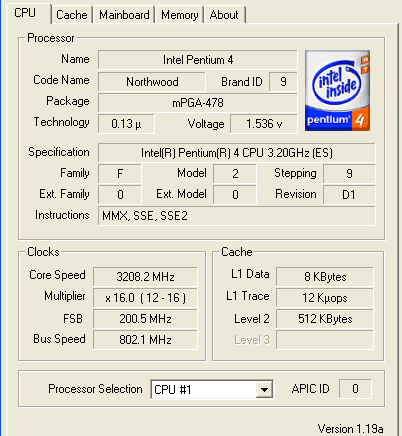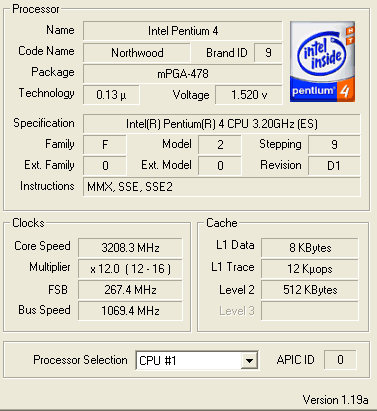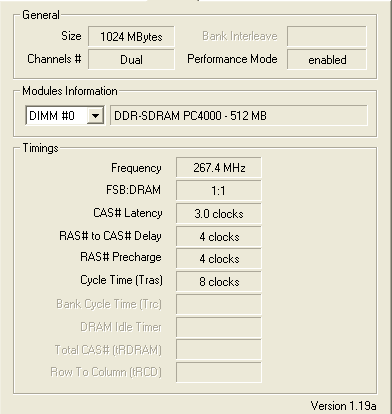Systems setup, notes, O/C
Here's a quick rundown of the test system should you wish to compare benchmark results with your own.- Intel Pentium 4 3.2GHz ES 800FSB CPU
- AMD Barton XP3200+ S462 CPU (2200MHz / 200FSB)
- ABIT IC7-MAX3 i875P Canterwood
- EPoX 4PDA2+ i865PE Springdale
- EPoX 8RDA3G nForce2 Ultra 400
Other components
- ATi Radeon 9800
Pro (380/340)
- 2 x 256MB Corsair XMS3500C2, run at 2-6-2-2 @ DDR400 for
all motherboards. Run with 'Street Racer' and 'Enhanced' extra timings on the IC7-MAX3. - 2 x 512MB OCZ4000 Dual Channel DDR500 memory, run at DDR534 (267.2MHz), at 3-4-4-8 Auto timings, for high FSB running.
- Liteon 16x DVD
- Samcheer 420w PSU
- Samsung 181T TFT monitor
- Akasa Silver Mountain cooler
- Thermaltake AX478 cooler with 25CFM Cooler Master fan
Software
- Windows XP Professional with
SP1
- DirectX9.0a
- Intel 5.00.1012 chipset drivers
- NVIDIA nForce 2.
45 drivers- ATI CATALYST 3.
7 drivers and control panel (6378s)- Pifast v41 to 10m places
- Lame v3.92 MP3 encoding with Razor-Lame 1.15 front-end using U2's Pop album
- SiSoft SANDRA
MAX3 (9.73 release)- Hexus SETI benchmark
0.417WU - Realstorm Raytracing benchmark v1.10
- 3DMark 2001SE v330
- UT2003 Demo (Build 2206)
- X2: The Threat - Rolling Demo
- Comanche 4 benchmark
- Serious Sam 2 : Sierra De Chiapas Demo.
- Quake 3 v1.30 HQ
Notes
The MAX3 will be compared to perhaps one of the best Springdale boards currently available. With the new performance-enhancing BIOS that gives it PAT-like status, the EPoX 4PDA2+ has managed to eclipse the benchmarks laid down by any Canterwood board reviewed at HEXUS, and we've reviewed a few. The IC7-MAX3 will be run at the standard 2-6-2-2 memory timings in dual channel mode. It will also be run with the same timings but with Game Accelerator options selected (Street Racer and Enhanced). We want to see if these make a meaningful difference. They're reckoned to boost performance in memory-intensive tasks; our benchmarks will reveal all. The board will also be run with an inflated FSB and synchronous RAM. Informal testing showed that the MAX3 operated at 267MHz FSB without too many problems (one problem was the occasional failure to boot from a cold start). We managed to get some OCZ EL DDR PC4000 RAM up to 267MHz in dual channel mode, but with relaxed 3-4-4-8 Auto timings. The idea was to show you, the reader, the effects of a high FSB and memory clock vs. relatively low FSB (200MHz) and super-tight memory timings. 267MHz FSB, when run with a 12x multiplier, gives us an identical running speed to a 3.2GHz P4 at stock.
Here's the stock speed and memory settings:


Here's the overclocked FSB and related memory settings. Note the 267.4MHz memory speed.


Pretty much identical CPU speeds. All that's changed is the frequency of the MCH and memory. The memory timings have been slackened off considerably so performance advantages may not be too apparent. Knocking down the memory ratio gave an overall FSB limit of around 285MHz. That's on the high side of the Canterwood bunch. We can either assume that's down to the extra OTES cooling, an unusually good yield on the MCH, or both. Benchmarks were conducted at 1024x768x32 @ 85Hz unless otherwise stated. The board installed into a standard Lian Li PC60 aluminium case without issue, and all devices and features loaded first time. The boards ran at the following speeds.
3222.6MHz - EPoX 4PDA2+
3208.2/3208.3MHz - ABIT IC7-MAX3
2205.1MHz - EPoX 8RDA3G / XP3200+
Issues
The board would often fail to post from a cold boot if the selected FSB was over ~255MHz. That was a consistent feature throughout testing. Another quirk was the inability to run a 5:4 FSB-to-memory ratio once the board was overclocked highly and tight latencies imposed on the RAM. It would POST but not load the OS. That's an important factor as many users won't have RAM that's capable of matching the board's and probable CPU's FSB. Higher latencies seemed to work fine with the 5:4 ratio. Again, it's hard to call this a criticism because it's in an overclocked environment, but the on-board sound often became a little flaky at 250FSB+









